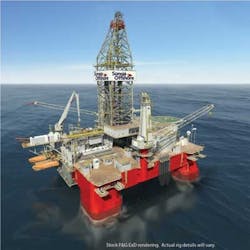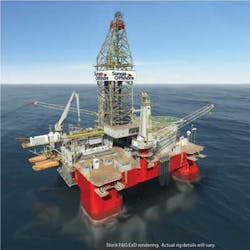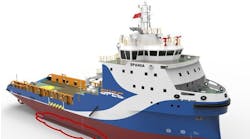Dieter Wijning - Huisman Equipment
One current industry focus is on how to work in areas with extreme water depths, harsh environments, or remote locations where the cost and risk of exploring and developing discoveries far exceeds those for regular fields.
These rougher conditions require specialized rigs and service vessels with larger payloads and deck space, so day rates are higher and availability problematic, necessitating timely and meticulous planning. Another major consideration for field development is the dependency on specialist service contractors in these regions. Any delay incurred by one party negatively influences the overall project planning and ultimately can slow progress towards first production.
These considerations led Huisman to initiate the design process – recently completed – for a speculative newbuild, self-propelled, semisubmersible DP-3 class drilling unit,JBF 14000 The numerical designation refers to its water depth rating in feet. The fully integrated equipment design and high-spec MODU allows for a relatively low displacement. Due to its large payload and free deck area, JBF 14000 can do ultra deepwater drilling and complete field development operations at remote locations around the world. In addition, its operational efficiency reduces safety risks.
Drilling system integration has led Huisman’s design agenda over the past few years. Examples include the drilling towers for the new Shell/Frontier deepwaterArctic Bully drillships, and Noble’s Globetrotter drillship, based on the company’s in-house “HuisDrill 12000” design.
Layout
The designs for the equipment and vessel have been fully integrated forJBF 14000. One significant result is the rig’s low displacement in relation to its operational capacities and in comparison with other existing rig designs. The in-house designed drilling mast without V-door limitation allows adjustment of the BOP handling procedure, eliminating the need for a substructure. This lowers the center of gravity and frees considerable deck space.
Vertical storage of the risers in the columns allows the center of gravity to be lowered further. And due to the drill floor being flush with the main deck, a usable deck area of at least 4,300 sq m (37,600 sq ft) is created. In addition, no braces have been installed between the pontoons, leading to more efficient fuel consumption, and facilitating installation of large templates.
These features make theJBF 14000 suitable for drilling operations and – with minor add-ons – field development operations worldwide, including extreme water depths and remote locations. The rig’s design permits drilling in up to 4,270 m (14,000 ft) water depth, with a total drilling depth capacity in excess of 12 km (40,000 ft) measured from sea level.
The drilling package is suitable for conventional drilling, expandable tubular drilling, and coiled tubing. Possible field development activities include the installation of subsea equipment, light and heavy workover, deepwater hoisting, and pipelay. The field development equipment can be used without interfering with the normal drilling process.
The vessel is designed with a drilling equipment set suitable for drilling and field construction activities and includes a box type drilling mast with 2 x 1,090-metric ton (2,400 kips) hook load capacity. Two pipe setback drums next to the mast can store 41.1-m (135-ft) stands with tubulars being transported vertically from the setback to the drilling center by four pipe rackers positioned around the mast.
Two pipe feeders between the mast and the aft deck bring the tubulars from a horizontal position on the pipe deck to a vertical position in the drilling or construction center. The drill floor at the construction center can be raised, enabling skidding and lowering of large objects such as BOPs in the moonpool using the construction hoist.
The hoists of the drilling mast are equipped with splittable traveling blocks comprising a main block with two fixed sheaves and six detachable single sheave blocks. Splitting the block is achieved by detaching pairs of sheave blocks from the traveling block and attaching them to the crown block. The 16-fall block can be split from 16 to 12, eight, or four falls. The flexibility gained is that the traveling block speed can be increased up to 400% versus being fully reeved as the hook load decreases during tripping operations. Splitting of the block is a push-button operation.
These vessel and equipment features – absence of an elevated substructure, large usable deck space, the closed box structure of the Huisman drilling mast, fully automated pipe handling and the vertical riser storage – also minimize risk and enhance crew safety.
The market is showing interest in theJBF 14000 because of its operational efficiency and, subsequently, its cost and risk savings potential.




